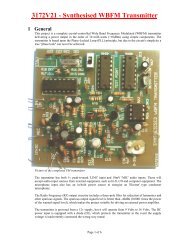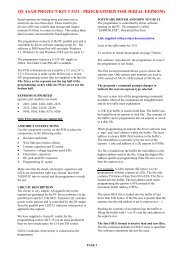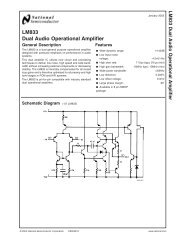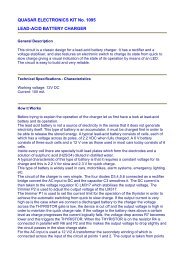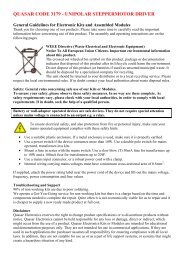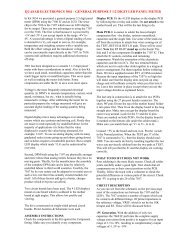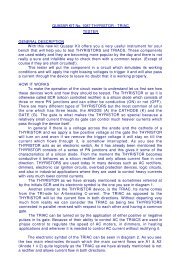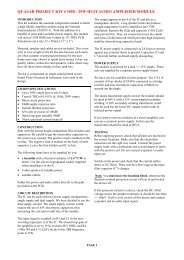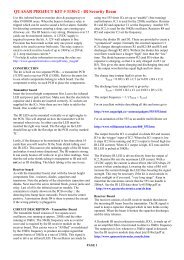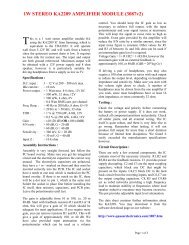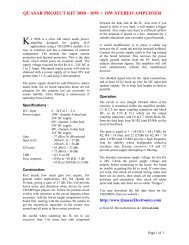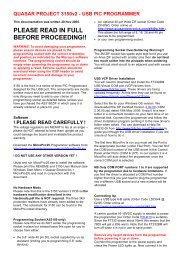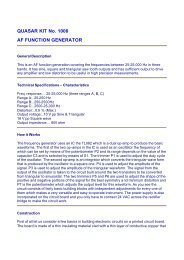QUASAR KIT No. 1117 TV PATTERN GENERATOR
QUASAR KIT No. 1117 TV PATTERN GENERATOR
QUASAR KIT No. 1117 TV PATTERN GENERATOR
Create successful ePaper yourself
Turn your PDF publications into a flip-book with our unique Google optimized e-Paper software.
<strong>QUASAR</strong> <strong>KIT</strong> <strong>No</strong>. <strong>1117</strong><br />
<strong>TV</strong> <strong>PATTERN</strong> <strong>GENERATOR</strong><br />
General Description<br />
A pattern generator is a very useful instrument for the correct alignment of the timing<br />
circuits of a television set. The circuit we propose you to build, is a «bar generator» that<br />
will produce horizontal and vertical stripes (bars) on the <strong>TV</strong> screen, that will help you align<br />
the vertical and horizontal scanning synchronisation circuits of the receiver.<br />
Technical Specifications - Characteristics<br />
Working voltage: ................... 9 VDC<br />
Current drawn: ...................... 2 mA<br />
Operating Frequency: ........... 170 - 250 MHz (VHF)<br />
Horizontal scan frequency: ... 16525 Hz<br />
Vertical scan frequency: ....... 50 Hz<br />
Output impedance: ............... 75 ohm<br />
How it Works<br />
The circuit can be divided in five different stages. Four astable multivibrators and the<br />
output stage which is built around the VHF oscillator.<br />
The first astable consists of two NOR gates in U2 and the components R9, R15, D4, C8,<br />
and C10. The two NOR gates are used as inverters and together they form an astable<br />
multivibrator which oscillates at a frequency of 16525 Hz, which is the horizontal scan<br />
frequency of the <strong>TV</strong>, and can be fine-tuned by means of R15. The capacitor C10 is there<br />
to provide the necessary feedback to maintain the oscillations. The signal from the output<br />
of the oscillator is taken through C8 and R6 to the output stage and modulates it.<br />
The other multivibrator built around the other two NOR gates in U2, together with R12,<br />
R14, D6 and C12 produces the necessary pulses for the vertical scanning frequency which<br />
is 50 Hz. This frequency is fed to the input of one of the AND gates in U1 (pin 1).<br />
The multivibrator built around two of the NOR gates in U3 and the components R13, R17,<br />
C9 and D7 produces the pauses between pulses, which after being fed to the AND gates<br />
in U1 (pins 8, 9 and 10) which are connected as inverters are then also used to modulate<br />
the oscillator and appear on the <strong>TV</strong> screen as vertical stripes (bars).<br />
Finally the last multivibrator which consists of the remaining two NOR gates in U3 together<br />
with the components R1, R11, R16, C7 and D5 produces the pulses which appear on the<br />
screen as horizontal lines.<br />
All four multivibrators are based on the same operating principle. They are elementary<br />
oscillators using NOR gates and a feed back element which is either a capacitor or a<br />
resistor (depending on the operating frequency) and all of them incorporate a trimmer to<br />
permit slight adjustments to their operating frequency.<br />
The output signals from the three inverters in U1 are taken through D3, R7 and D2 to the<br />
VHF oscillator. This is a common base circuit which has a low input resistance and
elatively high voltage amplification. The output frequency of the oscillator is determined by<br />
the coil which is formed by the copper track on the PCB and the variable capacitor L1. This<br />
frequency is between 170 and 250 MHz and can be adjusted by the trimmer L1.<br />
The resistors R1 and R2 form a potential divider which controls the modulation level of the<br />
output oscillator and the trimmer R3 controls the contrast of the pattern against the back<br />
ground.<br />
Finally the transistor Q2 and its associated circuit (R2 and D1) form a voltage stabiliser for<br />
the circuit. The trimmers R14, and R15 control the vertical and horizontal scan frequencies<br />
respectively so that the image becomes steady and the squares on the screen appear<br />
perfect. The trimmers R16 and R17 set the number of the horizontal and vertical bars<br />
respectively.<br />
Construction<br />
First of all let us consider a few basics in building electronic circuits on a printed circuit<br />
board. The board is made of a thin insulating material clad with a thin layer of conductive<br />
copper that is shaped in such a way as to form the necessary conductors between the<br />
various components of the circuit. The use of a properly designed printed circuit board is<br />
very desirable as it speeds construction up considerably and reduces the possibility of<br />
making errors. <strong>QUASAR</strong> Kit boards also come pre-drilled and with the outline of the<br />
components and their identification printed on the component side to make construction<br />
easier. To protect the board during storage from oxidation and assure it gets to you in<br />
perfect condition the copper is tinned during manufacturing and covered with a special<br />
varnish that protects it from getting oxidised and also makes soldering easier.<br />
Soldering the components to the board is the only way to build your circuit and from the<br />
way you do it depends greatly your success or failure. This work is not very difficult and if<br />
you stick to a few rules you should have no problems. The soldering iron that you use<br />
must be light and its power should not exceed the 25 Watts. The tip should be fine and<br />
must be kept clean at all times. For this purpose come very handy specially made sponges<br />
that are kept wet and from time to time you can wipe the hot tip on them to remove all the<br />
residues that tend to accumulate on it. DO NOT file or sandpaper a dirty or worn out tip. If<br />
the tip cannot be cleaned, replace it. There are many different types of solder in the market<br />
and you should choose a good quality one that contains the necessary flux in its core, to<br />
assure a perfect joint every time. DO NOT use soldering flux apart from that which is<br />
already included in your solder. Too much flux can cause many problems and is one of the<br />
main causes of circuit malfunction. If nevertheless you have to use extra flux, as it is the<br />
case when you have to tin copper wires, clean it very thoroughly after you finish your work.<br />
In order to solder a component correctly you should do the following:<br />
- Clean the component leads with a small piece of emery paper.<br />
- Bend them at the correct distance from the component’s body and insert the component<br />
in its place on the board.<br />
- You may find sometimes a component with heavier gauge leads than usual, that are too<br />
thick to enter in the holes of the P.C. board. In this case use a mini drill to enlarge the<br />
holes slightly. Do not make the holes too large as this is going to make soldering difficult<br />
afterwards.<br />
- Take the hot iron and place its tip on the component lead while holding the end of the<br />
solder wire at the point where the lead emerges from the board. The iron tip must touch<br />
the lead slightly above the p.c. board.<br />
- When the solder starts to melt and flow, wait till it covers evenly the area around the hole<br />
and the flux boils and gets out from underneath the solder. The whole operation should not
take more than 5 seconds. Remove the iron and leave the solder to cool naturally without<br />
blowing on it or moving the component. If everything was done properly the surface of the<br />
joint must have a bright metallic finish and its edges should be smoothly ended on the<br />
component lead and the board track. If the solder looks dull, cracked, or has the shape of<br />
a blob then you have made a dry joint and you should remove the solder (with a pump, or<br />
a solder wick) and redo it.<br />
- Take care not to overheat the tracks as it is very easy to lift them from the board and<br />
break them.<br />
- When you are soldering a sensitive component it is good practice to hold the lead from<br />
the component side of the board with a pair of long-nose pliers to divert any heat that<br />
could possibly damage the component.<br />
- Make sure that you do not use more solder than it is necessary as you are running the<br />
risk of short-circuiting adjacent tracks on the board, especially if they are very close<br />
together.<br />
- When you finish your work, cut off the excess of the component leads and clean the<br />
board thoroughly with a suitable solvent to remove all flux residues that may still remain on<br />
it.<br />
To build the pattern generator solder first of all the IC sockets on the P.C. board taking<br />
care to insert them correctly and then make the jumper connections and solder the pins for<br />
the external connections. Continue with the resistors and the capacitors, again making<br />
sure that the electrolytic are inserted the right way round, and finally solder in place the<br />
diodes and the transistors, taking care to avoid overheating them with the soldering iron.<br />
Place the trimmers and the variable capacitor in their places and solder the battery clip’s<br />
leads across the points marked (+) and (-), pins 4 and 1 respectively.<br />
At this point make a very careful inspection of your work and if you are sure that everything<br />
is OK take the IC’s from their aluminium wrap, which is there to protect their delicate<br />
circuits from static discharges and insert them very carefully in their sockets. Be especially<br />
careful in the process, to avoid touching the pins with your hands and also to avoid<br />
bending them between the IC’s and the sockets.<br />
To get the best performance from your generator it is highly recommended to enclose it in<br />
a metal case which will shield all stray radiation that could possibly cause trouble in use. (If<br />
you use a metal case the shielding of the output cable should be connected to the case by<br />
means of a 5 or 10 pF ceramic capacitor). The generator can be connected to the <strong>TV</strong> set<br />
under test either directly using a piece of coaxial cable connected between the points 3<br />
(signal) and 2 (earth) of the circuit and the VHF antenna input of the receiver, or if the<br />
receiver is sensitive enough and the instrument is not very far the connection by cable may<br />
not be necessary because the transmitter section of the generator is quite powerful.<br />
Adjustments<br />
- Connect the output of the generator by means of a coaxial cable with the input of your <strong>TV</strong><br />
receiver.<br />
- Turn the receiver on and select a VHF channel (say ch. 5).<br />
- Set R3 in the middle of its travel.<br />
- Using a plastic tuning screwdriver adjust L1 till you get an image on the <strong>TV</strong> screen even if<br />
it is distorted.<br />
- Adjust R14 till the vertical stripes become more defined.<br />
- Adjust R15 so that the horizontal stripes appear on the screen.<br />
- By adjusting R16 and R17 select the number of horizontal and vertical stripes that will be
displayed on the screen.<br />
- Re-adjust R14 to make the horizontal stripes completely steady.<br />
- Finally touch again R14, R15, R16, and R17 to get the best possible image definition and<br />
set the image contrast by means of the trimmer R3.<br />
Warning<br />
<strong>QUASAR</strong> kits are sold as stand alone training kits.<br />
If they are used as part of a larger assembly and any damage is caused, our company<br />
bears no responsibility.<br />
While using electrical parts, handle power supply and equipment with great care, following<br />
safety standards as described by international specs and regulations.<br />
If it does not work<br />
Check your work for possible dry joints, bridges across adjacent tracks or soldering flux<br />
residues that usually cause problems.<br />
Check again all the external connections to and from the circuit to see if there is a mistake<br />
there.<br />
- See that there are no components missing or inserted in the wrong places.<br />
- Make sure that all the polarised components have been soldered the right way round. -<br />
Make sure the supply has the correct voltage and is connected the right way round to your<br />
circuit.<br />
- Check your project for faulty or damaged components.<br />
If your project still fails to work, please contact us for information about our Get-You-Going<br />
service.<br />
Schematic Diagram
Parts List<br />
All components including printed circuit board, assembly instructions including schematics<br />
and detailed parts list are supplied when you purchase the kit.<br />
Ordering<br />
For pricing info and online ordering please visit:<br />
http://www.quasarelectronics.com/<strong>1117</strong>.htm<br />
For further info please contact us by e-mail:<br />
mailto: sales@QuasarElectronics.com<br />
COPYRIGHT © 2003 Quasar Electronics Limited. All rights reserved. Reproduction of this document in<br />
whole or in part in any form or medium without express written permission of Quasar Electronics Limited is<br />
prohibited.<br />
E&OE



